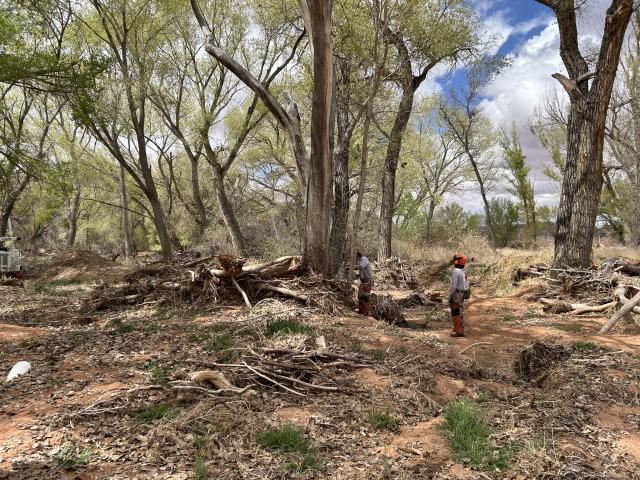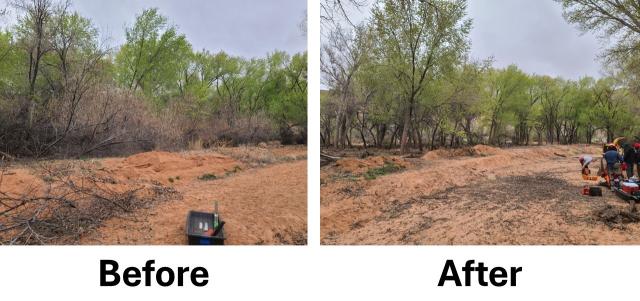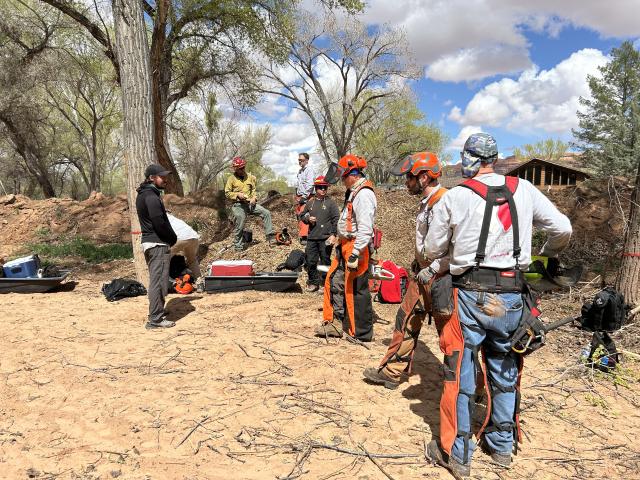Tackling fire fuels with friends
Saws grinding, branches crackling, a wood-chipper whirs and crunches — this is fire fuels mitigation and disaster response at its auditory core. Massive floods along Moab’s many creeks caused havoc last summer; densely foliated floodplains captured and held debris, preventing water from escaping to the Colorado River. As flood waters backed up, sandbags were piled to protect homes, property and lives.
Sometimes the saying “it takes a village” doesn’t quite cover the full scope of the need. When it comes to fire fuels reduction and disaster response, well, it takes volunteers from a 450-mile radius around Moab. That, and groups of partners from state and federal agencies, like the Bureau of Land Management.
However, the major heavy lifters (quite literally) for this project were a volunteer crew of 30 people, who spent five days reducing invasive Russian olive and elm trees to near dust. The volunteers? Well, they are known as Team Rubicon: a veteran-led, coed organization of citizens who want to do good and find their own connections and community in the process.
When asked why he would choose to volunteer doing such physically intensive work, Jeff Myer, retired Army artilleryman, responded, “More like why not?” adding, “chainsaws, wilderness...” said with a wide, boyish grin.

To be clear, this work was not being performed in designated wilderness, where tools like chainsaws are not allowed, it is actually not even on BLM land, but rather on private land along Mill Creek and adjacent to Matheson Preserve. The BLM has partnered with Team Rubicon several times as part of its community assistance service, aimed at helping individuals and communities to adapt to, prepare for, and respond to wildfire.
The two areas singled out for this project were both inundated with invasive plants, a fire and flood hazard. At the Mill Creek site, homeowners told the crew there was a creek at the back of their property and Team Rubicon couldn’t believe it. But after five days and 35,000 cubic feet of fuels material being whittled down to scraps (across both sites), the unassuming Mill Creek appeared. All told, the crew cleared debris from about 6.5 acres — more than 5 football fields — of land.

Removing the understory of brush, debris and invasive plants not only removes fire fuels and flood hazards, it reduces the risk of fires on public lands adjacent to project sites and improves watershed health along creeks and the Colorado River. It can serve as invasive species migration mitigation as well.
“The BLM sincerely appreciates the work of Team Rubicon. We have worked alongside their volunteers many times over the years and share their passion and commitment to making communities safer and more resilient to wildfires and floods,” said JB Clay, fire management specialist - prevention “We are happy to have them here, not only as a land management agency but also as residents ourselves.”

Team Rubicon was formed after the founders, William McNulty and Jake Wood, witnessed victims of devastating natural disasters — like hurricanes, floods and fires — go without the aid they so desperately needed. Born from the need for response, the Team has incorporated prevention assistance as well. Team Rubicon has visited Moab six times since 2019. Each time, they work with city, state and federal partners who inform them of the greatest needs. A project is determined, the order is sent, and volunteers from the surrounding states rally to our community’s aid.
Team Rubicon trains their volunteers on all aspects of the work, then the teams are divided into sawyers and “swampers”. The sawyers, using saws, get to work getting vegetation to a manageable size, and the swampers do the heavy lifting, getting branches and logs to the woodchipper, or collecting wood in more desirable locations.
From doing good for goods’ sake, to learning new skills, the impact is immeasurable both individually and on a bigger scale. This important volunteer work has a positive, yet difficult-to-quantify economic impact on the community. Whether clearing debris from major storm and fire events, mitigating for future ones, or providing peace of mind to our local residents and visitors — any way you saw it, this work is a HUGE win, win, win!
Anna Rehkopf, Public Affairs Specialist - Canyon Country District
